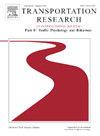通过自动驾驶汽车外部环境的感知和预测信息进行信任校准
IF 3.5
2区 工程技术
Q1 PSYCHOLOGY, APPLIED
Transportation Research Part F-Traffic Psychology and Behaviour
Pub Date : 2024-09-28
DOI:10.1016/j.trf.2024.09.019
引用次数: 0
摘要
保持适当的信任度对于自动驾驶汽车的驾驶安全至关重要。众所周知,在自动驾驶中增强驾驶员对系统信息的态势感知(SA)可显著促进信任校准,但在驾驶过程中增强驾驶员对外部环境的态势感知是否有助于这种校准仍不清楚。本研究通过在各种驾驶环境中提高三级(L3)自动驾驶期间对外部环境的感知能力来填补这一空白。驾驶环境是通过包含低、中、高环境风险的不同道路条件来操控的。为了提高驾驶员对驾驶环境的感知能力,我们重新设计了车载中央控制面板,以显示有关外部驾驶环境的实时感知和预测信息。我们假设,驾驶环境的可感知性将促进信任校准,而不仅仅是增强信任,从而使信任在不同的驾驶条件下调整到适当的水平。实验 1 考察了有关道路、交通基础设施和周围车辆的感知信息对驾驶员信任度的影响。我们发现,只有在使用重新配置的面板时,驾驶员的信任度才会随着环境风险的增加而降低,而事故数量则不受影响。实验 2 调查了外部环境的预测信息对驾驶员信任度的影响,方法是将驾驶员车辆周围的安全区和危险区分别标记为绿色和红色。我们发现,预测信息根据路况调整了信任度,并提高了整体信任度,而事故数量却不受影响。这些研究结果表明,加强对外部环境的感知和预测有助于驾驶员根据 L3 自动驾驶中的环境风险水平调整其信任度,而不会影响驾驶安全。本文章由计算机程序翻译,如有差异,请以英文原文为准。
Trust calibration through perceptual and predictive information of the external context in autonomous vehicle
Maintaining an appropriate level of trust is critical for driving safety in autonomous vehicles. While enhancing the driver’s situation awareness (SA) of system information in autonomous driving is known to significantly promote trust calibration, it remains unclear whether enhancing the driver’s SA of the external context during driving contributes to this calibration. This study addresses this gap by improving SA of the external context during Level 3 (L3) driving automation across various driving environments. Driving contexts were manipulated using distinct road conditions containing low, medium, or high contextual risks. To enhance driver’s SA of the driving context, we redesigned the in-vehicle central control panel to display real-time perceptual and predictive information about the external driving context. We hypothesized that SA of driving contexts would facilitate trust calibration rather than merely enhancing trust, allowing trust to adjust to appropriate levels under different driving conditions. Experiment 1 examined the impact of perceptual information about the road, traffic infrastructure, and surrounding vehicles on drivers’ trust. We found that driver’s trust decreased with increased contextual risk only when the reconfigured panel was used, while the number of accidents was not affected. Experiment 2 investigated the effect of predictive information about the external context on drivers’ trust by marking safe and dangerous zones around driver’s vehicle with green and red areas, respectively. We revealed that the predictive information calibrated the trust according to road conditions and increased overall trust levels, while the number of accidents was not affected. Together, these findings suggest that enhancing perception and prediction of external contexts helps drivers align their trust with contextual risk levels in L3 driving automation without compromising driving safety.
求助全文
通过发布文献求助,成功后即可免费获取论文全文。
去求助
来源期刊
CiteScore
7.60
自引率
14.60%
发文量
239
审稿时长
71 days
期刊介绍:
Transportation Research Part F: Traffic Psychology and Behaviour focuses on the behavioural and psychological aspects of traffic and transport. The aim of the journal is to enhance theory development, improve the quality of empirical studies and to stimulate the application of research findings in practice. TRF provides a focus and a means of communication for the considerable amount of research activities that are now being carried out in this field. The journal provides a forum for transportation researchers, psychologists, ergonomists, engineers and policy-makers with an interest in traffic and transport psychology.

 求助内容:
求助内容: 应助结果提醒方式:
应助结果提醒方式:


